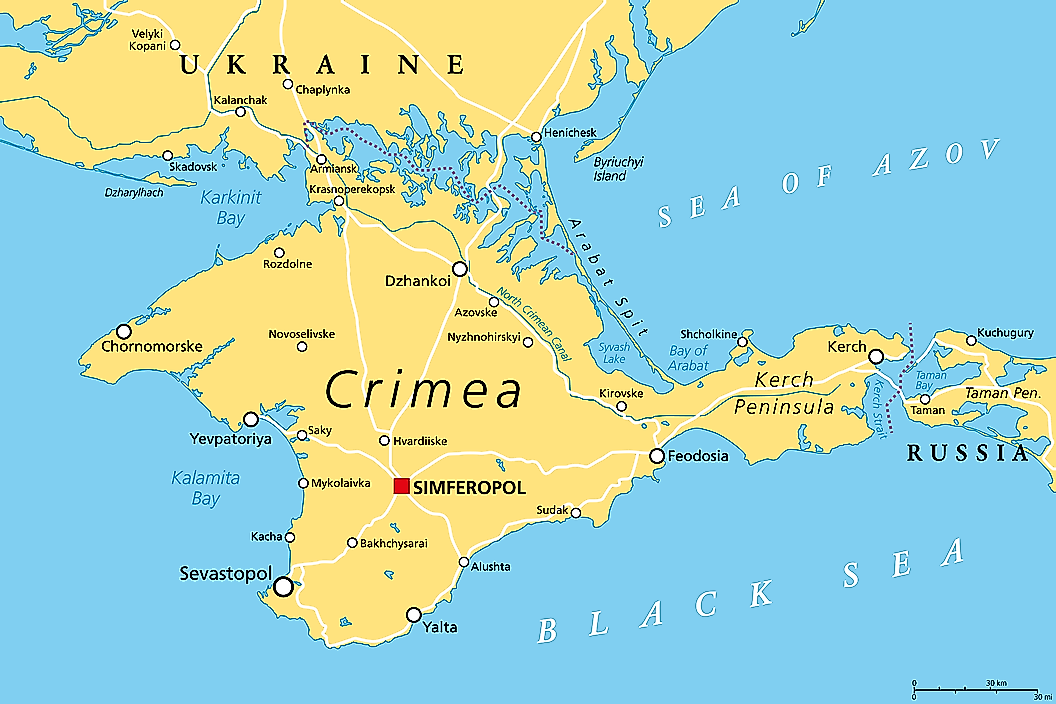
Crimea
Few spots on our blue marble have demonstrated a more important geographical significance than Crimea.
Recently in the world consciousness again due to the Russian invasion of Ukraine, the Crimean Peninsula sits at the confluence of waters, continents, and, seemingly, history. Across the ages, countless nations and peoples have called Crimea home and fought for its control. From the ancient Greeks to the Russian invasion in 2014, this region never seems far from the geopolitical epicenter.
As a new war rages through Ukraine, let’s explore this unique site.



As the maps above zoom in, Crimea’s special location emerges. Jutting out from Ukraine into the Black Sea, the peninsula contains a natural strategic bounty. Though the Black Sea is technically an arm of the Mediterranean, it functions as an enormous inland sea, touching six nations and draining multiple major rivers. The Crimean Peninsula dominates the northern portion of the Black Sea, which provides a boon to those who control it.
As you can see in the final map, Crimea is one meeting spot between Ukraine and Russia. In many ways, the peninsula can be viewed as a metaphorical border between Europe and Asia, or the East and the West. This demarcation is not a modern invention. From deep parts of history, humans viewed Crimea as the border between the classical world and the steppes (read: “civilization” versus “hordes”).
An incomplete list of the peoples who have populated this land includes the Ancient Greeks, the Persians, the Roman Empire, the Byzantine Empire, the Scythians, the Goths, the Huns, the Mongols, and the Golden Horde. Of course, a complete list would also include Russia. Catherine the Great’s Russian Empire conquered the Khanate in charge of Crimea in 1783. Between 1853 and 1856, Russia fought the Crimean War against France, Britain, the Ottoman Empire, and Sardinia. The Battle of Balaclava provided impetus for Alfred Lord Tennyson to pen the famous poem, “The Charge of the Light Brigade.” (Aside: incredibly, a wax cylinder recording of Tennyson reading the poem survives!)
As long as humans have fought over land, they have toiled for the Tauric Peninsula, as it was known until the modern period.

In the expertly curated Paint markup of Crimea above, you can see a few of the main geographical features of the peninsula.
Crimea is nearly an island. The Isthmus of Perekop connects the region to Ukraine. This strip is between 3 and 4 miles wide. To the northeast lies the Sea of Azov. A long sliver called the Arabat Spit separates the Sea of Azov from the Sivash, also known as the Rotten Sea. This “sea” is closer to a series of lagoons than proper big water. Connecting the Sea of Azov and the Black Sea is the Strait of Kerch, which also separates Crimea from Russia.
Much to our delight at TMAC HQ, the peninsula also features a mountain range! The Crimean Mountains line the southern shore along the Black Sea. Though these crags do not produce eye-popping heights, they rise starkly from the sea, producing wonderful relief. Roman-Kosh, the highest mountain in Crimea, tops out at 5,069 feet.



Three-quarters of Crimea consists of prairie, called steppe. The steppe melts into the mountain range. Between the two, they form the bulk of Crimea’s landmass. Because the mountains lurch so suddenly from the sea, the narrow area between them and the coast exhibits a different climate from the rest of the peninsula. The “Crimean Riviera” falls closer to subtropical than the temperate climate of the rest of the region. The Riviera attracts beachgoers galore, in times of non-combat, at least.


The Crimean Peninsula appears to be stocked with natural beauty. Its geographical significance dooms it to seemingly perpetual turnover and warfare. A true shame, as the native people do not deserve the turmoil and the world should easily visit these splendid shores.
Perhaps, one day, human divisions will no longer need geographically strategic peninsulas. That day will be a great one for Crimea.
Further Reading and Exploration
Crimea – Encyclopedia Britannica
Crimean Mountains – Internet Encyclopedia of Ukraine+
The History and Geography of Crimea – ThoughtCo.
The Charge of the Light Brigade – Alfred Lord Tennyson
The Charge of the Light Brigade on Wax Cylinder













